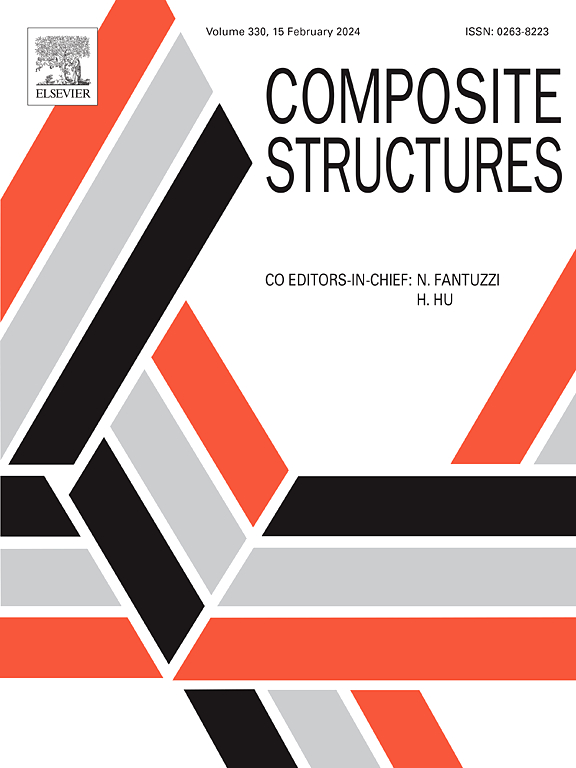Periodic free vibrations of composite laminates with curvilinear fibres and CNTs
IF 6.3
2区 材料科学
Q1 MATERIALS SCIENCE, COMPOSITES
引用次数: 0
Abstract
This article addresses the combined effect of using curvilinear fibres and carbon nanotubes (CNTs) reinforcements in the non-linear modes of vibration of laminated composite plates. To arrive at the material properties of the three-phase composite material, a two-step hierarchic procedure is followed. A modified version of the Halpin–Tsai model is employed to predict the Young’s modulus of the CNT enriched resin and expressions, deduced from equilibria of a unit cell where a fibre is embedded in resin, are applied to obtain the diverse elasticity moduli of the three-phase composite. Moderately large displacements are considered, with von Kármán strain–displacement relations. Although the presented model is an equivalent single layer one, it applies to thick plates, because a Third-order Shear Deformation Theory (TSDT) is followed. The set of autonomous non-linear equations of motion is reduced using static condensation and a modal basis with selected modes, chosen after a convergence analysis. The reduced set of equations of motion is solved by the shooting method. Numerical tests considering plates with diverse curvilinear fibre paths, CNT contents and thicknesses are carried out. The results obtained are thoroughly analysed.
带有曲线纤维和碳纳米管的复合材料层压板的周期性自由振动
本文探讨了在层压复合材料板的非线性振动模式中使用曲线纤维和碳纳米管(CNTs)增强材料的综合效果。为了得出三相复合材料的材料特性,本文采用了两步分层法。采用改进版的 Halpin-Tsai 模型来预测富含 CNT 树脂的杨氏模量,并应用从纤维嵌入树脂的单胞平衡中推导出的表达式来获得三相复合材料的不同弹性模量。利用 von Kármán 应变-位移关系考虑了中等较大的位移。尽管所提出的模型是等效单层模型,但由于采用了三阶剪切变形理论(TSDT),因此适用于厚板。利用静态压缩和经过收敛分析选择的模态基础,减少了自主非线性运动方程组。缩减后的运动方程组采用射击法求解。对具有不同曲线纤维路径、CNT 含量和厚度的板材进行了数值测试。对获得的结果进行了全面分析。
本文章由计算机程序翻译,如有差异,请以英文原文为准。
求助全文
约1分钟内获得全文
求助全文
来源期刊

Composite Structures
工程技术-材料科学:复合
CiteScore
12.00
自引率
12.70%
发文量
1246
审稿时长
78 days
期刊介绍:
The past few decades have seen outstanding advances in the use of composite materials in structural applications. There can be little doubt that, within engineering circles, composites have revolutionised traditional design concepts and made possible an unparalleled range of new and exciting possibilities as viable materials for construction. Composite Structures, an International Journal, disseminates knowledge between users, manufacturers, designers and researchers involved in structures or structural components manufactured using composite materials.
The journal publishes papers which contribute to knowledge in the use of composite materials in engineering structures. Papers deal with design, research and development studies, experimental investigations, theoretical analysis and fabrication techniques relevant to the application of composites in load-bearing components for assemblies, ranging from individual components such as plates and shells to complete composite structures.
 求助内容:
求助内容: 应助结果提醒方式:
应助结果提醒方式:


